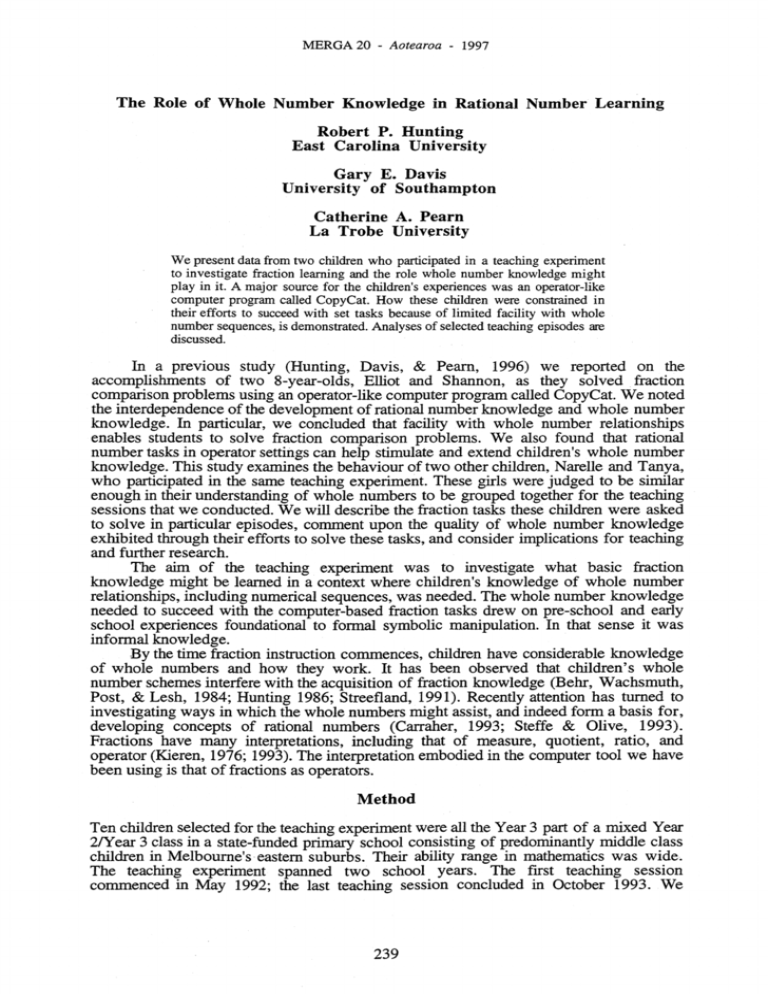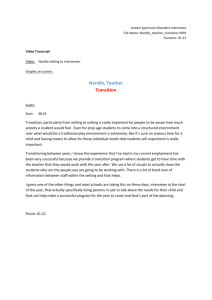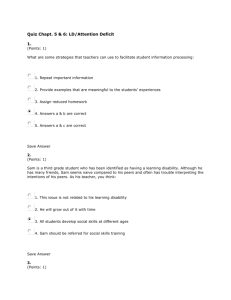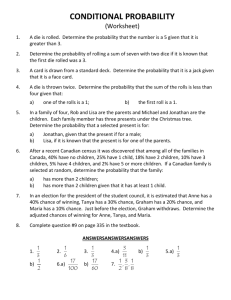The Role of Whole Number Knowledge in Rational Number
advertisement

MERGA 20 - Aotearoa - 1997 The Role of Whole Number Knowledge in Rational Number Learning Robert P. Hunting East Carolina University Gary E. Davis University of Southampton Catherine A. Pearn La Trobe University We present data from two children who participated in a teaching experiment to investigate fraction learning and the role whole number knowledge might play in it. A major source for the children's experiences was an operator-like computer program called CopyCat. How these children were constrained in their efforts to succeed with set tasks because of limited facility with whole number sequences, is demonstrated. Analyses of selected teaching episodes are discussed. In a previous study (Hunting, Davis, & Pearn, 1996) we reported on the accomplishments of two 8-year-olds, Elliot and Shannon, as they solved fraction comparison problems using an operator-like computer program called CopyCat. We noted the interdependence of the development of rational number knowledge and whole number knowledge. In particular, we concluded that facility with whole number relationships enables students to solve fraction comparison problems. We also found that rational number tasks in operator settings can help stimulate and extend children's whole number knowledge. This study examines the behaviour of two other children, Narelle and Tanya, who participated in the same teaching experiment. These girls were judged to be similar enough in their understanding of whole numbers to be grouped together for the teaching sessions that we conducted. We will describe the fraction tasks these children were asked to solve in particular episodes, comment upon the quality of whole number knowledge exhibited through their efforts to solve these tasks, and consider implications for teaching and further research. The aim of the teaching experiment was to investigate what basic fraction knowledge might be learned in a context where children's knowledge of whole number relationships, including numerical sequences, was needed. The whole number knowledge needed to succeed with the computer-based fraction tasks drew on pre-school and early school experiences foundational to formal symbolic manipulation. In that sense it was informal knowledge. By the time fraction instruction commences, children have considerable knowledge of whole numbers and how they work. It has been observed that children's whole number schemes interfere with the acquisition of fraction knowledge (Bebr, Wachsmuth, Post, & Lesh, 1984; Hunting 1986; Streefland, 1991). Recently attention has turned to investigating ways in which the whole numbers might assist, and indeed form a basis for, developing concepts of rational numbers (Carraher, 1993; Steffe & Olive, 1993). Fractions have many interpretations, including that of measure, quotient, ratio, and operator (Kieren, 1976; 1993). The interpretation embodied in the computer tool we have been using is that of fractions as operators. Method Ten children selected for the teaching experiment were all the Year 3 part of a mixed Year 2/Year 3 class in a state-funded primary school consisting of predominantly middle class children in Melbourne's· eastern suburbs. Their ability range in mathematics was wide. The teaching experiment spanned two school years. The first teaching session commenced in May 1992; the last teaching session concluded in October 1993. We 239 MERGA 20 - Aotearoa - 1997 conducted teaching sessions twice weekly for periods of three weeks at a time. Each session lasted approximately 20-25 minutes. In a typical morning we would conduct three to four sessions; each session working with groups of two or three children. Tanya and Narelle were aged 7 years 10 months, and 8 years 3 months at the time of initial interviews. The Computer Tool The Copycat is an operator-like computer based learning tool developed in Hypertalk 2.0 for use on Apple MaGintosh computers. Experiments performed may be directed at determining what fraction is responsible for observed numerical inputs and corresponding outputs, or at determining the numerical value of inputs or outputs for selected fractions governing the Copycat's behaviour. On the Copycat itself are three "buttons;" each can be activated with a mouse-click when the cursor is positioned over it (see Figure 1). The arrow buttons control the number of counters placed on the "in-tray". Counters are added or subtracted one at a time. The Go button activates a script which determines what the Copycat will do. If the number of counters placed on the in-tray is divisible by the fraction denominator, d, and the Go button is clicked, an observer sees a group of d counters removed, one at a time, from the in-tray; simultaneously a distinctive sound is heard. Next, counters appear one at a time in the output tray until the number of counters in the tray equals the number in the numerator of the selected fraction. A new pound accompanies the appearing fraction. This process continues until all the counters in the in-tray have been used up. Finally, to the accompaniment of applause, all the counters reappear in the input tray; and the windows, above the words "In" and "Out," display the number of input and output counters. If the number of input counters is not divisible by d, the Copycat "explodes" to appropriate noises. Other buttons-·visible and invisible--can be used to reset the machine after each experiment and to activate a screen to cover the selected fraction. The fraction can be selected by choosing a restricted set of numerators and denominators from the menu bar at the top of the display (not visible in Figure 1). Figure 1: Graphical features of the Copycat Results We will discuss the behaviour of Narelle and Tanya from three teaching episodes; one near the beginning, one near the middle, and one near the end of the experiment. 240 MERGA 20 - Aotearoa - 1997 June 5, 1992 episode This session occurred early in the teaching experiment--on the third meeting after intial interviews had taken place to determine entering knowledge of whole numbers, sharing and fractions (Peam, 1996). Gary Davis was the teacher on this occasion. In the group were four girls, Narelle, Tanya, Sarah, and Dianne. CopyCat was set to I ' with the fraction visible. The general goal of each experiment was to predict the number of output items for each number of items input. Initial experiments were conducted with two, three, and four input items. The girls chose to call these items balls. CopyCat output one ball for two, exploded for three balls, and output two balls for four. Gary then input 20, followed by 12 balls. Tanya answered 10 balls for 20, and Dianne answered 6 balls for 12. The next three input numbers-24, 30, and 7-showed that numerical halving was indeed a restricted scheme for these girls, as the following excerpt demonstrates. Narelle first proposed 14 as the output from 24. Sarah agreed, and the other girls were easily convinced that this suggestion would be right. Similarly, for 30, one of the girls predicted an output of 20 balls, and the other girls agreed. For 7, Narelle suggested 5I balls, which indicated some understanding of the relation between odd and even numbers, and one-half. Seven was tested, and immediately after CopyCat exploded Tanya announced: You can't have odd numbers in it... Narelle: Because its half. Gary: Do you understand what she was saying Dianne? Tell us again Tanya what you mean by that. Narelle: (placing fingers down on table sequentially) 2,4, 6, 8, ... Gary: Tell us what you mean, you can't have odd numbers. What does that mean? Tanya: It means that 2, 4, 6, 8, ... you can only have 2, 4, 6, 8, up to 100. Gary: Mm. Okay. But not like 1,3, 5, 7, ... Narelle: Yeah. Because that's an odd number, like if you have two, you have a partner and if you have three its one odd (holding up three fingers and touching one of them). A few minutes later, Narelle chose to input 50 items, but Tanya objected: That's an odd number. You can't have it. Cath (observing at the side): Is it? Narelle: (turning round to face Cath): Its an odd number. Cath: Fifty's an odd number. Gary: Well press the (Go) button and find out. Narelle: Its an odd number. Gary: An odd number. You don't think there's partners in 50. Let's have a look. Tanya: Because there's five, and then there's (utterance indistinguishable). Narelle: (Presses Go button, which sets CopyCat processing). Gary asked in turn if 10, 20,30 were odd numbers. The girls hesitated for 10, then said no, said no for 20, but yes for 30. Gary asked one of the girls to input 30 items, and as this was being done, asked again if 30 could be made into partners. Each responded no. Even though Tanya had the insight that CopyCat set to couldn't deal with odd numbers, and further, even numbers could be identified up to 100, these children's functionality with the concept of odd and even numbers was limited--on the evidence-to 20. Thirty was odd because it contained the odd digit 3; likewise in the case of 50. On the other hand, Tanya's observation was evidence of a mathematical generalization, although limited to her experience of even numbers up to 100. In fact, her conception of even numbers was limited to numbers less than 50, as her objection to 50 indicates. Narelle's reference to partners was an attempt to explain the meaning of even numbers at a physical level. The word partner may have also been a generalization for Narelle, since that word implies a pairing·up of any number of items, but grounded in specific experience. Further t 241 MERGA 20 - Aotearoa - 1997 experiments with CopyCat, using inputs such as 30 and 50, would allow modification of these children's understanding of odd and even. In this episode we witness the interrelation between whole number knowledge and fraction knowledge, in the context of these types of tasks using CopyCat set to operate as a half machine. To be able to succeed these children needed knowledge of specific number sequences, namely, ones and twos, and coordinations that would allow them to relate one to the other. It is clear that these children did have some basic knowledge. They knew half of 2 and 4. They knew 10 was double 5, 12 was double 6, and 20 was double 10. Both Tanya and Narelle began spontaneously uttering the verbal number name sequence for twos up to eight. We know from their initial interviews that both girls were able to count forwards by twos from 2 to 30, forward by twos from 1, and backwards by twos from 24. Later when Gary used Narelle's idea of partners, involving the six people in the room (three children and three researchers), they could visualise half of 6. But knowledge of 24, for example, being a number in a sequence of ones, and at the same time a number in a sequence of twos (which has correlates that are half, such as 12 in the case of 24), was not activated in this context. For a concept of even number to be functional in this context, we consider that the number sequence of ones has to· be reconstitutable as composite units of two, where these units are a higher order than enactive or sensory motor units (Steffe, Cobb, & von Glasersfeld, 1988). A composite unit is a unit that is itself composed of units (Steffe, Cobb, & von Glasersfeld, 1988; Steffe, 1994). The CopyCat experiments allowed these children to extend their whole number schemes, just as their knowledge of number sequences limited their success with the experiments. October 20, 1992 A different type of task was presented to the children on Friday October 16, and Tuesday October 20. An input number and corresponding output number were presented on a worksheet containing a representation of the CopyCat. There were no countable items on either the input tray or the output tray on the worksheet representation. The children were encouraged to experiment with the computer. The fraction was screened. The task was to discover what fraction was responsible for the input number and output result. In this episode we observed Narelle counting balls by groups on the input tray as a way of checking if the predicted fraction would be correct. In the first task a worksheet was shown with numerals 16 and 8 for input and output respectively. The computer CopyCat was blank, but set to with the fraction t t as their first hypothesis. We say surprisingly, because just four days earlier both girls had readily proposed t for an identical task. The CopyCat was set to operate as the fraction t ,. 16 balls were input. Of course the CopyCat exploded. Tanya then suggested t. The girls decided to test it, with negative result. Narelle then proposed t, set the CopyCat to that fraction, and input 16 screened from view. Surprisingly, both children suggested balls. Robert: Now, how many do we want to come out here (pointing to Out tray)? Do you think a quarter will do it? Narelle: (Excited) hold on ... (goes to screen counting under her breath while pointing her index finger at each of the first 12 balls displayed) one, two, three, four, (slight pause) one, two, three, four, (slight pause) one, two, three, four. (She did not count the last four balls.) Robert: Narelle what were you doing there? You were counting de, de, de, de, .... Narelle: I don't think it will work. 242 MERGA 20 - Aotearoa - 1997 Robert: You don't think it will work. Why not? What do you think will come out? Narelle: Urn, (points finger at input tray on screen and begins counting balls again) one, two, three, four (pause, then whispers) this four is one, (continues counting inaudibly, pausing after a count of four, counts sets of four subvocally). That, ... four will come out. Narelle had invented a way to check whether the CopyCat fraction would work, without having to test it. The numerical information given as 16 was insufficient for her. She needed sensory material upon which to act. It is most likely that her scheme was triggered by the proposed fraction denominator, in this case four. She counted segments of four from the display of 16 balls. Her provisional conclusion that the machine would not work-that is, would not output 8 balls-was confirmed when she focused on tallying how many lots of four were contained in 16. Later in this session, Narelle used the same strategy to reject as the fraction that would output 4 from 16 balls, confirmed that a 16- t t 4 result would result from a t machine, and voted down Tanya's proposal that the fraction 110 might contribute to a 16-2 situation. Narelle's strategy was limited in that it eliminated fractions that would not work, rather than identify the fraction that would. There were some tasks for which Narelle and Tanya gave instant answers, without needing to measure out lots of balls. For example, immediately after the above task involving 16 balls in and 8 balls out, the girls saidk for 8 in, 4 out; 10 in, 5 out; and 16 in, 8 out again. But apart from such common relationships, tasks presented using a worksheet in which no countable items were available, were probably beyond Narelle's reach. Narelle did not know 16 as a composite unit of 4 fours, but she was able to construct this new knowledge, using the visual material on the screen. From an observer's perspective, the obvious way to deal with CopyCat tasks where the fraction is unknown, is to divide output by input. By virtue of there being a given· output, for CopyCat, a fraction must necessarily exist. Such logic was not available to these children. But these children had yet to develop the formal relation of division as the reverse of multiplication. August 25, 1993 On this occasion Narelle and Tanya were given the task of determining the CopyCat fraction, where that fraction was screened from view. In the first part of the session the fraction was set to To begin with, 18 balls appeared on the input tray and 6 balls appeared on the output tray. We observed three instances where Narelle and Tanya used counting and grouping strategies; either by representing input numbers using tallies on paper, or by counting directly from the computer screen. Narelle began using a partitioning model, but this scheme was not well established, and broke down for her in the face of several CopyCat experiments. Tanya's scheme was more attuned to the operations of CopyCat. She counted out lots corresponding to the posited fraction denominator. Narelle's initial response to the 18 in, 6 out, shown on the CopyCat, was to suggest that it was a half machine. While the teacher (Robert) was preparing a table to record experiments, with the headings In and Out, Narelle offered a counter-example to contradict her initial hypothesis, observing that if the Input number was 16, then the output wouldn't be 6. Tanya also remarked that half of 18 was 9. Narelle extended the fingers on both hands on front of her. Then on a sheet of paper provided by the teacher Narelle drew 18 small circular marks. She drew three larger closed curves around sets of six circular marks, looked up, and announced "I think it's a one-third machine". The teacher asked what would come out if 6 balls were input, if the CopyCat were a one-third t. 243 MERGA 20 - Aotearoa - 1997 machine. Tanya said three would come out; Narelle hesitated but did not argue. The experiment was conducted, with two balls being output. Twelve was proposed as thenext input number to be tested. Narelle first suggested 6 as output, then reminded herself that such a result would indicate a half machine. Tanya said 4, reasoning thus: 'Cause if it was half of 6 it would have been three. Narelle: Half of 12 would be 6. Tanya: (Looks down at data appearing on sheet of paper) four. Tanya may have extrapolated, reasoning that if 6 output 2, then 12 would have to output less than 6. She then changed her mind to 3. Narelle concluded 4 after drawing on her sheet of paper. She was not sure if the result would be 3 or 4. Just before Tanya began to test 12 using the computer, Narelle suddenly said: Hold on! Don't touch it. (She began point-counting items on the screen) one, two, three, four, one, two, three, four, one, two, three, four. Oh, I'll have to do it again. Narelle repeated the same counting procedure, except this time she kept a tally of the lots of four by extending fingers on her left hand. She and Tanya both concluded three would be output. But immediately Tanya went to the screen and began point-counting inaudibly. She changed her mind, confidently announcing "four's going to come out. Four's going to come out." Both girls counted three lots of four but came to different conclusions about what the output number would be. Narelle took the result of her tally of fours-three. Tanya put a different structure on the 12 items visible on the screen. We infer that she counted lots of three. Running the CopyCat confirmed Tanya was right. She did not express any sign of surprise at the result. Our inference is supported by a comment Tanya made to Narelle immediately after the conclusion of the 12-4 CopyCat result: "you counted by fours, not threes". The teacher next asked what would happen if 24 balls were input. Narelle clicked 24 balls one by one on to the in-tray, commenced counting items, but became distracted when she noticed Tanya extending her fingers one by one. Tanya sequentially extended five fingers on one hand, then three fingers on the other, without speaking. She began again more deliberately, pausing after extending the seventh finger. "I think it's going to blow up" was her prediction. Tanya's counting sequence by three's was not robust enough to provide her with the solution. A mis-count likely led to a number other than 24 at the conclusion of her finger count. Tanya began counting screen items, asked Narelle for a pen, and drew a row of 24 small vertical marks on a sheet of paper. She encircled lots of three marks working from left to right, then announced 8 was going to come out. N arelle clicked on the Go button, and at the conclusion· of the process, completed the data sheet, and said it was a one-third machine. with the fraction In the second part of the session the CopyCat was set to screened once again. The initial data was 6 in 4 out. The teacher asked what would be output for 18 input. The children thought about it for 30 seconds, then Tanya suggested it might be a fourth machine. Eighteen items were input and Tanya knew before setting CopyCat to Go that was not right, because she was unable to divide 18 evenly by counting lots of four on the screen. Her next strategy was to draw 18 tallies on paper. She first confrrmed her earlier decision that CopyCat was not a machine, by encircling groups of four tally marks. She discovered that 18 could be subdivided into 9 lots of 2, and concluded CopyCat was a machine. This hypothesis was subsequently disconfirmed when 12 items were output. The next suggestion-a one-third machinewas refuted by evidence from previous experiments. The fraction was more difficult for r' t t t these children than was r t. 244 MERGA 20 - Aotearoa - 1997 t, In the August 25 teaching session, the CopyCat was set initially to and the task for the children was to discover what that fraction was since it was screened from view. The only way to find out was to investigate the results of inputting various numbers. If the input number was a multiple of three, the CopyCat would process that number; if not, it would explode. A record of successful input and output experiments was made on a sheet of paper to help the children remember experiments that worked. Narelle's scheme for working out what would be output for an input of 18 balls may have been based on a partitioning model, but how did she know the number of sub-units? Rather, it seems more plausible that Narelle took the output of 6 balls as a unit which was used to measure the 18. After observing the results of her work on paper, she noticed three equal groups of 6, hence her conclusion. Whereas in the case of 18 she associated the number of units of six with the needed fraction, in the case of 12, she knew there would be 3 lots of 4, but associated the number of lots of four with the output number, not the fraction. Thus she predicted 3 balls would be output. Tanya also used various devices to represent numbers in order to segment quantities. She used her fingers, but needed more permanent perceptual records on which to operate. She imposed a structure of threes on 24 tally marks. She had an implicit understanding of the operation of the CopyCat, enough for success. She did not understand one-third as an operation closely related to formal division. Rather, one-third was tied to counts of three. The degree of facility these girls had with numerical sequences, particularly in the case of one-third, sequences of threes, determined success in these tasks. Discussion In these three teaching episodes we have seen how Narelle's and Tanya's success with tasks involving the CopyCat was constrained by their whole number knowledge, particularly knowledge of number sequences, interrelationships between sequences having different units, and the development of numerical relationships we might call factors. Two beliefs encouraged us to test an operator model of rational numbers in an experiment on fraction learning. First, we knew children bring to school a great wealth of informal knowledge about whole numbers, and that early childhood mathematics programs focus on developing and extending whole number skills and concepts. The CopyCat is an interpretation of rational numbers that draws on numerical relationships. We wanted to see how this approach to learning fractions was able to tap what children already knew. Second, we wanted to establish fraction knowledge beyond just associating symbols with restricted visual and physical quantities. We wanted children to understand, for example, that one-half is the relation that is common to 2 of 4, 3 of 6, 4 of 8, and so on. The CopyCat enabled the children to perform rapid experiments, which we hoped would engender deeper conceptions of fractions. . At the outset, we assessed the children's counting, partitioning, and fraction knowledge in clinical interviews. Tanya and Narelle were fluent with verbal counting forwards and backwards by twos, at least into the third decade. Neither child was successful counting forward by threes. It was no surprise then, that these girls constantly used one-half as a reference for checking possible results of CopyCat experiments. On the other hand, recognition of doublelhalf relationships was limited to specific cases, such as 10-5, 12-6, 20-10, and so on. These children made the generalisation of numbers that could be halved to numbers that could have partners, and understood the significance of even and odd numbers to a limited extent. Thirty and 50 were odd because they contained a 3 and 5. Not only do children need to be able to operate on number sequences, they need to be able to conceive of numbers as composite units-indeed as simultaneously comprising units of different size. Sixteen can be segmented into four units of 4, and also, through a mental shift of focus, into eight units of 2, or two units of 8. Narelle and Tanya had yet to develop the deeper understanding of number patterns incorporating different composite 245 MERGA 20 - Aotearoa - 1997 units. Their behaviour is consistent with children who Steffe, Cobb, and von Glasersfeld's (1988) would say have constructed the initial number sequence. They were yet to, in general, establish the first few whole numbers as iterable units (Steffe, 1994). Development of fraction knowledge in this setting was stimulating the creation of whole number knowledge which in turn enabled success with the fraction tasks. References Behr, M. J., Wachsmuth, I., Post, T., & Lesh, R. (1984). Order and equivalence or rational numbers: A clinical teaching experiment. Journal for Research in Mathematics Education, 15(5),323-34l. Carraher, D. W. (1993). Building rational number concepts upon students' prior understanding. Paper presented at the International conference on Rational Number Learning, University of Georgia, Athens, GA. ~unting, R. P. (1986). Rachel's schemes for constructing fraction knowledge. Educational Studies in Mathematics, 17, 49-66. . Hunting, R. P., Davis, G., & Pearn, C. A. (1996). Engaging whole number knowledge for rational number learning using a computer-based tool. Journal for Research in Mathematics Education, 27, 354-379. Kieren, T. (1976). On the mathematical, cognitive, and instructional foundations of rational numbers. In R. Lesh (Ed.), Number and measurement: Papers from a research workshop (pp. 101-144). Columbus OH: ERIC/SMEAC. Kieren, T. E. (1993). Rational and fractional numbers: From quotient fields to recursive understanding. In T. P. Carpenter, E. Fennema, & T. A. Romberg (Eds.), Rational numbers: An integration of research (pp. 49-84). Hillsdale NJ: Lawrence Erlbaum. Pearn, C. A. (1996). Steffe, L. P. (1994). Children's multiplying schemes. In G. Harel & J. Confrey (Eds.), The development of multiplicative reasoning in the learning of mathematics (pp. 3-39). Albany, NY: SUNY Press. Steffe, L. P., Cobb, P., & von Glasersfeld, E. (1988). Construction of arithmetical meanings and strategies. New York: Springer-Verlag. Steffe, L. P., & Olive, J. (1993). Children's mathematical learning in computer microworlds. Paper presented at the conference of the International Working Group on Rational Number Learning, University of Georgia, Athens, GA. Streefland, L. (1991). Fractions in realistic mathematics education. Dortrecht: Kluwer. 246







